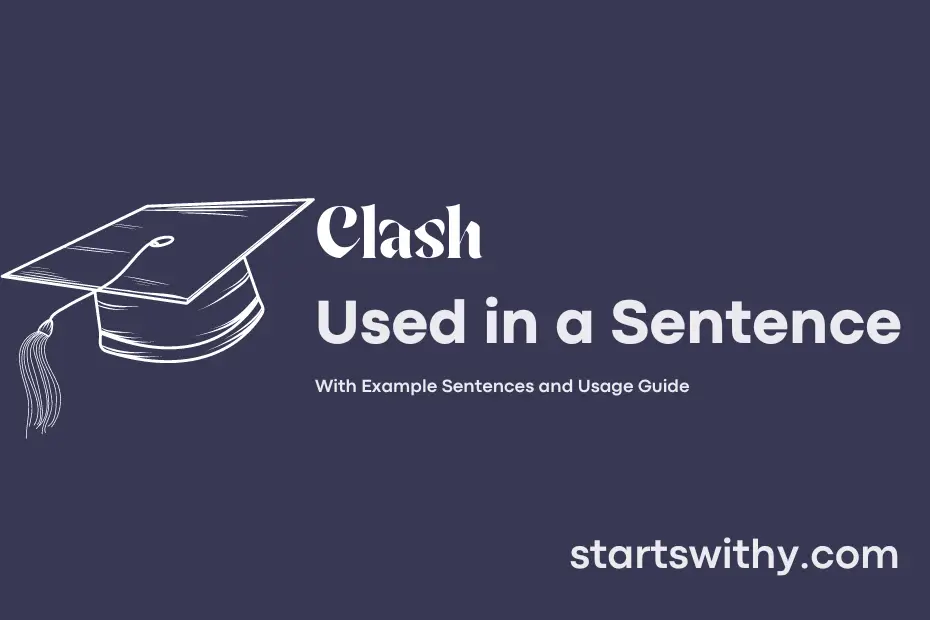When contrasting ideas, opinions, or beliefs oppose each other in a disagreement, they create a clash. This clash results in a conflict or argument as the parties involved have opposing perspectives that are not easily reconciled.
Clashes can arise in various scenarios, from personal relationships and workplace dynamics to societal debates and political ideologies. Understanding how to navigate these clashes and find common ground is essential for effective communication and conflict resolution.
7 Examples Of Clash Used In a Sentence For Kids
- Clash the cymbals together to make music.
- The colors of the two cars clashed in the parking lot.
- The waves clashed against the rocks at the beach.
- The two friends had a small clash over a toy.
- The red and blue crayons clashed on the paper.
- The loud noises of the thunder and lightning clashed during the storm.
- The two teams clashed on the playground during recess.
14 Sentences with Clash Examples
- Clash of opinions between classmates often leads to healthy debates in college.
- In the cafeteria, there was a clash of preferences between those who preferred North Indian and South Indian cuisine.
- The clash between organizing committees caused delays in planning the college fest.
- The clash between studying for exams and attending social events can be a struggle for many students.
- A clash of ideas emerged during the group project presentation, leading to a heated discussion.
- There was a clash of schedules when two important workshops were scheduled at the same time.
- The clash between the senior and junior students over hostel rules created tension on campus.
- The clash of cultures was evident during the college’s annual cultural fest.
- The clash between academic pressure and extracurricular activities was a common theme among students.
- The clash between the college authorities and student unions often resulted in protests and strikes.
- A clash of personalities among group members affected the dynamics of the team project.
- The clash of study styles between classmates highlighted the diversity in learning approaches.
- A clash between the college band members during rehearsals caused disruptions in their performance.
- The clash of interests between students pursuing different majors led to varied perspectives in classroom discussions.
How To Use Clash in Sentences?
To use the word “Clash” in a sentence, start by understanding its meaning. “Clash” is a verb that means to come into conflict or disagreement with someone or something.
Here is an example of how to use “Clash” in a sentence:
“The two rival groups clashed during the protest, leading to a chaotic situation.”
When using “Clash” in a sentence, make sure it is in the appropriate context to convey a sense of conflict, disagreement, or confrontation. You can use it to describe clashes between individuals, groups, ideas, or even colors or styles.
Here are a few more examples of using “Clash” in sentences:
- “The politician’s stance on the issue clashed with public opinion.”
- “The vibrant red and bright orange colors clash in this artwork.”
- “The two actors clashed on set due to creative differences.”
Remember to pay attention to the tone and context of your sentence when using the word “Clash.” Using it correctly will help you convey the idea of conflict or disagreement effectively. Feel free to practice using “Clash” in different sentences to become more comfortable with its application.
Conclusion
In conclusion, the varied examples of sentences using the keyword ‘clash’ demonstrate its versatile applications in different contexts. From describing conflicting opinions or contrasting elements to illustrating physical confrontations or clashes of colors, the word ‘clash’ encapsulates a wide range of meanings. These sentences highlight how ‘clash’ can convey the idea of disagreement, collision, or even a striking visual effect.
Overall, the keyword ‘clash’ serves as a potent tool for expressing discord or opposition, whether in ideas, actions, or aesthetics. By examining its usage in various scenarios, one can appreciate the rich nuances and dynamics that this word brings to communication, making it a valuable addition to vocabulary for conveying diverse concepts with clarity and impact.



